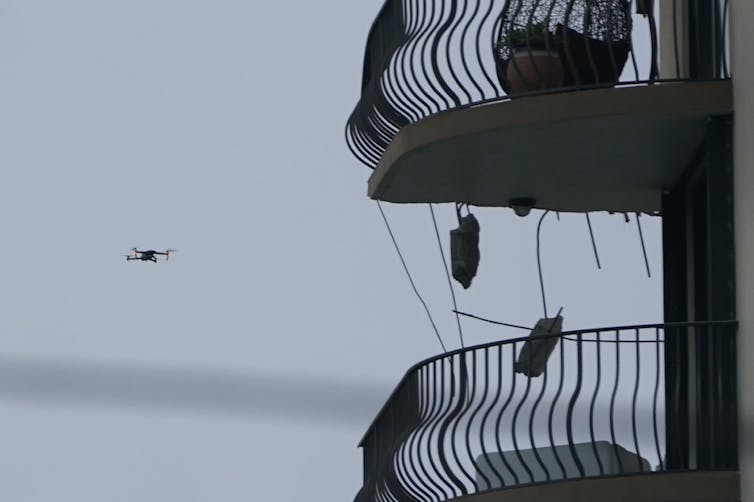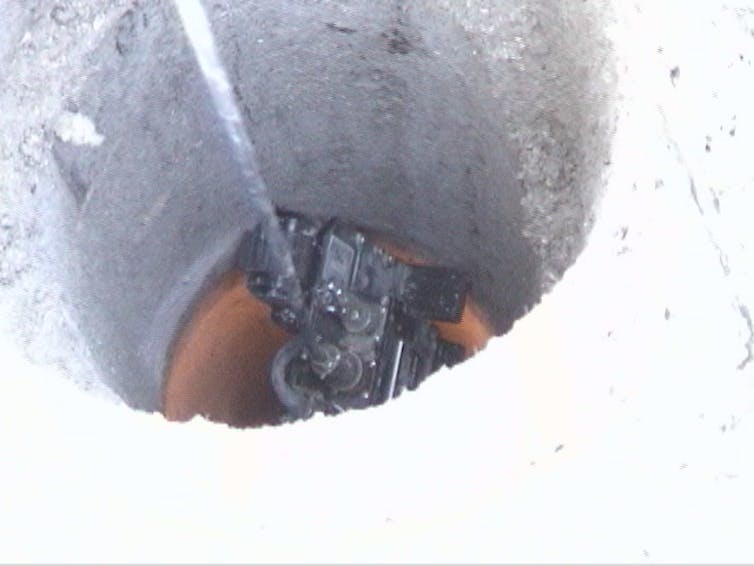An expert on search and rescue robots explains the technologies used in disasters like the Florida condo collapse
- Written by Robin R. Murphy, Raytheon Professor of Computer Science and Engineering; Vice-President Center for Robot-Assisted Search and Rescue (nfp), Texas A&M University
Texas A&M’s Robin Murphy has deployed robots at 29 disasters, including three building collapses, two mine disasters and an earthquake as director of the Center for Robot-Assisted Search and Rescue[1]. She has also served as a technical search specialist with the Hillsboro County (Florida) Fire and Rescue Department. The Conversation talked to Murphy to provide readers an understanding of the types of technologies that search and rescue crews at the Champlain Towers South disaster site in Surfside, Florida, have at their disposal, as well as some they don’t. The interview has been edited for length.
What types of technologies are rescuers using at the Surfside condo collapse site?
We don’t have reports about it from Miami-Dade Fire Rescue Department, but news coverage shows that they’re using drones.
A standard kit for a technical search specialist would be basically a backpack of tools for searching the interior of the rubble: listening devices and a camera-on-a-wand or borescope[2] for looking into the rubble.
How are drones typically used to help searchers?
They’re used to get a view from above to map the disaster and help plan the search, answering questions like: What does the site look like? Where is everybody? Oh crap, there’s smoke. Where is it coming from? Can we figure out what that part of the rubble looks like?
In Surfside, I wouldn’t be surprised if they were also flying up to look at those balconies that are still intact and the parts that are hanging over. A structural specialist with binoculars generally can’t see accurately above three stories. So they don’t have a lot of ability to determine if a building’s safe for people to be near, to be working around or in, by looking from the ground.
 Search and rescue personnel use a drone to inspect the upper floors of the remaining portion of the Champlain Towers South Condo building.
AP Photo/Wilfredo Lee[3]
Search and rescue personnel use a drone to inspect the upper floors of the remaining portion of the Champlain Towers South Condo building.
AP Photo/Wilfredo Lee[3]
Drones can take a series of photos to generate orthomosaics[4]. Orthomosaics are like those maps of Mars where they use software to glue all the individual photos together and it’s a complete map of the planet. You can imagine how useful an orthomosaic can be for dividing up an area for a search and seeing the progress of the search and rescue effort.
Search and rescue teams can use that same data for a digital elevation map. That’s software that gets the topology of the rubble and you can start actually measuring how high the pile is, how thick that slab is, that this piece of rubble must have come from this part of the building, and those sorts of things.
How might ground robots be used in this type of disaster?
The current state of the practice for searching the interior of rubble is to use either a small tracked vehicle, such as an Inkutun VGTV Extreme[5], which is the most commonly used robot for such situations, or a snakelike robot, such as the Active Scope Camera[6] developed in Japan.
Teledyne FLIR is sending a couple of tracked robots[7] and operators to the site in Surfside, Florida.
Ground robots are typically used to go into places that searchers can’t fit into and go farther than search cameras can. Search cams typically max out at 18 feet, whereas ground robots have been able to go over 60 feet into rubble. They are also used to go into unsafe voids that a rescuer could fit in but that would be unsafe and thus would require teams to work for hours to shore up before anyone could enter it safely.
In theory, ground robots could also be used to allow medical personnel to see and talk with survivors trapped in rubble, and carry small packages of water and medicine to them. But so far no search and rescue teams anywhere have found anyone alive with a ground robot.
What are the challenges for using ground robots inside rubble?
The big problem is seeing inside the rubble. You’ve got basically a concrete, sheetrock, piping and furniture version of pickup sticks. If you can get a robot into the rubble, then the structural engineers can see the interior of that pile of pickup sticks and say “Oh, OK, we’re not going pull on that, that’s going to cause a secondary collapse. OK, we should start on this side, we’ll get through the debris quicker and safer.”
Going inside rubble piles is really hard. Scale is important. If the void spaces are on the order of the size of the robot, it’s tricky. If something goes wrong, it can’t turn around; it has to drive backward. Tortuosity – how many turns per meter – is also important. The more turns, the harder it is.
There’s also different surfaces. The robot may be on a concrete floor, next thing it’s on a patch of somebody’s shag carpeting. Then it’s got to go through a bunch of concrete that’s been pulverized into sand. There’s dust kicking up. The surroundings may be wet from all the sewage and all the water from sprinkler systems and the sand and dust start acting like mud. So it gets really hard really fast in terms of mobility.
The author’s work includes putting robots through their paces at Texas A&M’s ‘Disaster City,’ a training facility with full-scale mockups of disaster sites including collapsed buildings.What is your current research focus?
We look at human-robot interaction. We discovered that of all of the robots we could find in use, including ours – and we were the leading group in deploying robots in disasters – 51% of the failures during a disaster deployment were due to human error.
It’s challenging to work in these environments. I’ve never been in a disaster where there wasn’t some sort of surprise related to perception, something that you didn’t realize you needed to look for until you’re there.
What is your ideal search and rescue robot?
I’d like someone to develop a robot ferret. Ferrets are kind of snakey-looking mammals. But they have legs, small little legs. They can scoot around like a snake. They can claw with their little feet and climb up on uneven rocks. They can do a full meerkat, meaning they can stretch up really high and look around. They’re really good at balance, so they don’t fall over. They can be looking up and all of a sudden the ground starts to shift and they’re down and they’re gone – they’re fast.
How do you see the field of search and rescue robots going forward?
There’s no real funding for these types of ground robots. So there’s no economic incentive to develop robots for building collapses, which are very rare, thank goodness.
And the public safety agencies can’t afford them. They typically cost US$50,000 to $150,000 versus as little as $1,000 for an aerial drone. So the cost-benefit doesn’t seem to be there.
 An Inuktun crawling robot being lowered into a hole at the World Trade Center site in 2001.
Courtesy Center for Robot-Assisted Search and Rescue
An Inuktun crawling robot being lowered into a hole at the World Trade Center site in 2001.
Courtesy Center for Robot-Assisted Search and Rescue
I’m very frustrated with this. We’re still about the same level we were 20 years ago at the World Trade Center.
[Get our best science, health and technology stories. Sign up for The Conversation’s science newsletter[8].]
References
- ^ Center for Robot-Assisted Search and Rescue (crasar.org)
- ^ borescope (www.digitalcameraworld.com)
- ^ AP Photo/Wilfredo Lee (newsroom.ap.org)
- ^ orthomosaics (www.youtube.com)
- ^ Inkutun VGTV Extreme (youtu.be)
- ^ Active Scope Camera (www.rm.is.tohoku.ac.jp)
- ^ tracked robots (www.flir.com)
- ^ Sign up for The Conversation’s science newsletter (theconversation.com)

















